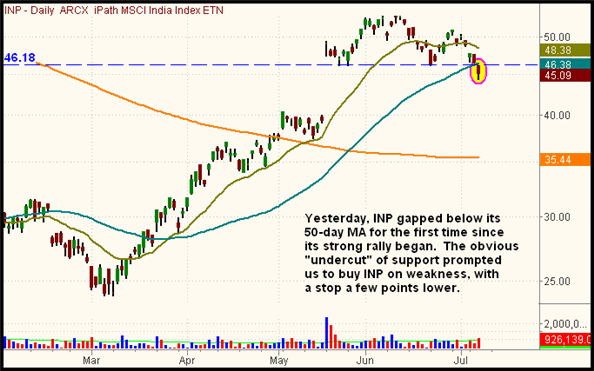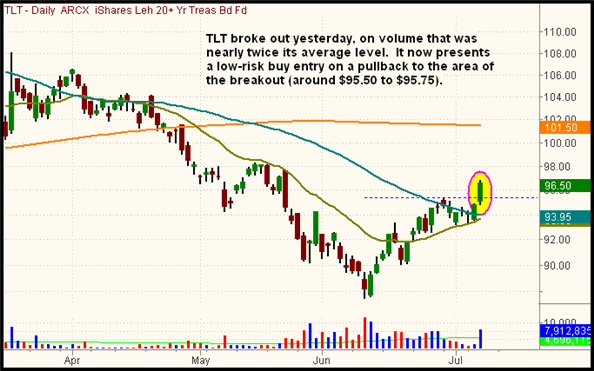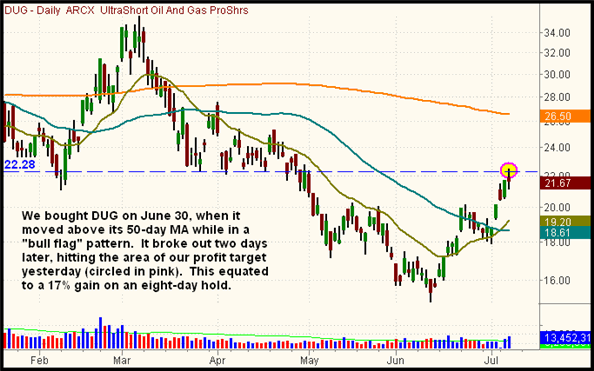|
The Wagner Daily ETF Report For July 9
Building on bearish momentum from the previous day's break of key levels of price support, the major indices were facing another round of substantial losses yesterday afternoon, but a late-day recovery enabled stocks to finish near the flat line. The S&P 500, down 1.4% at its intraday low, reversed to finish just 0.2% lower. The Dow Jones Industrial Average turned a 0.9% intraday decline into a 0.2% closing advance. The Nasdaq Composite eked out a gain of 0.1%. Small and mid-cap stocks lagged behind, as the Russell 2000 and S&P Midcap 400 indices lost 0.8% and 0.5% respectively. The main stock market indexes closed just above the middle of their intraday ranges.
Volume swelled across the board, enabling turnover to move back above 50-day average levels. Total volume in the NYSE rose 29%, while volume in the Nasdaq similarly increased 26% above the previous day's level. Since yesterday's percentage changes in the S&P and Nasdaq were so minimal, the volume patterns indicated neither confirmed accumulation or distribution. However, a closer look "under the hood" of the market reveals the bears actually maintained the upper hand. Despite the Nasdaq's 0.1% closing gain, declining volume in the exchange still exceeded advancing volume by approximately 3 to 2. In the NYSE, declining volume outpaced advancing volume by more than 2 to 1. These unimpressive breadth readings hint that yesterday's late-day recovery was a bit deceiving.
The iPath India Index (INP) was one of the strongest international ETFs throughout the rally from March through June 2009. Yesterday, it gapped down to close below 50-day moving average for the first time since its current uptrend began. However, since it was an obvious "undercut" of key price support, as well as its first test of the 50-day MA, we saw the weakness as a buying opportunity, and bought INP shortly after the open. In today's pre-market session, INP is presently indicated to open near yesterday's high, which could cause it to snap back above its 50-day MA pretty quickly. Because of the relative strength INP has been exhibiting, it should hold up well, relative to the broad market:

The fixed-income (bond) ETFs broke out yesterday, perhaps aided by the return of fear in the stock market. The iShares 20+ year T-bond (TLT), a benchmark ETF for the fixed-income market, climbed 1.8% yesterday, a rather large gain in the fixed-income market. Volume also rose to nearly double its average level, confirming demand from the breakout above price resistance. Now, if TLT pulls back to the area of its breakout level, it will present a low-risk buying opportunity. Furthermore, remember the fixed-income ETFs also pay regular (usually monthly) dividends, an added bonus. The potential entry point is illustrated on the daily chart below:

Yesterday afternoon, we sold our position in UltraShort Oil and Gas ProShares (DUG) into strength, locking in a 17% gain on a trade that was held for eight days. Our exit in DUG was near our initial profit target, which correlated to resistance from a band of previous price consolidation. Although DUG could easily move higher from here, it first is likely to correct by time (consolidate) or price (pull back) in the short-term. Rather than sitting through a correction, we chose the easier route of securing the quick gain from momentum of the initial breakout. On the daily chart below, the dashed horizontal line marks the resistance level that represented our price target on this short-term trade:

After yesterday's close, corporate earnings season officially kicked off with the latest numbers from Alcoa, Inc. (AA). In the coming weeks, a plethora of market-moving companies will begin heralding their earnings reports as well. Since there is a lot of speculation floating around as to whether or not the economy has really turned the corner, traders will be closely watching these numbers. As with every quarterly earnings season, one should expect volatile price movement in the stock market, driven by reactions to key earnings reports. But this time around, the reactions could be even more extreme. Keep that in mind with new position entries, as it may be wise to reduce your position size to account for the possibility of a highly volatile, news-driven market in the near-term.
Open ETF positions:
Long - DXD, SRS, INP
Short - (DXD and SRS are inversely-correlated "short ETFs")
Deron Wagner is the Founder and Head Trader of both Morpheus Capital LP, a U.S. hedge fund, and MorpheusTrading.com, a trader education firm.
|